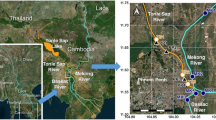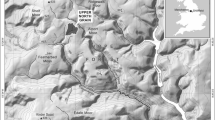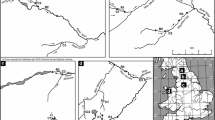Abstract
In-stream processing of allochthonous dissolved organic carbon (DOC) and particulate organic carbon (POC) in peat-sourced headwaters has been shown to be a significant part of the terrestrial carbon cycle, through photo- and bio-degradation, with both DOC and POC converted to carbon dioxide (CO2). This study reports a series of 70-h, in situ experiments investigating rates of degradation in unfiltered surface water from a headwater stream in the River Tees, North Pennines, UK. Half the samples were exposed to the normal day/night cycle (ambient); half were continuously dark. The study found that the DOC concentration of samples in the ambient treatment declined by 64 % over the 70 h, compared with 6 % decline for the samples kept in the dark. For POC, the loss in the ambient treatment was 13 %. The average initial rate of loss of DOC in the ambient treatment during the first day of the experiment was 3.36 mg C/l/h, and the average rate of photo-induced loss over the whole 70 h was 1.25 mg C/l/h. Scaling up these losses, the estimate of total organic carbon loss from UK rivers to the atmosphere is 9.4 Tg CO2/year which would be 0.94 % of the global estimate of CO2 emissions from streams and rivers from the 2013 IPCC report. Initial rate kinetics in the light were as high as 3rd order, but the study showed that no single rate law could describe the whole diurnal degradation cycle and that separate rate laws were required for night and day processes. The comparison of dark and ambient treatment processes showed no evidence of photo-stimulated bacterial degradation.






Similar content being viewed by others
References
Aitkenhead MJ, Aitkenhead-Peterson JA, McDowell WH, Smart RP, Cresser MS (2007) Modelling DOC export from watersheds in Scotland using neural networks. Comput Geosci 33:423–436
Bartlett RJ, Ross DS (1988) Colorimetric determination of oxidizable carbon in acid soil solutions. Soil Sci Soc Am J 52:1191–1192
Battin TJ, Luyssaert S, Kaplan LA, Aufdenkampe AK, Richter A, Tranvik LJ (2009) The boundless carbon cycle. Nat Geosci 2:598–600
Billett MF, Charman DJ, Clark JM, Evans CD, Evans MG, Ostle NJ, Worrall F, Burden A, Dinsmore KJ, Jones T, McNamara NP, Parry L, Rowson JG, Rose R (2010) Carbon balance of UK peatlands: current state of knowledge and future research challenges. Clim Res 45:13–29
CIA (2010) The World Factbook. CIA World Factb 20:2010
Cole JJ, Prairie YT, Caraco NF, McDowell WH, Tranvik LJ, Striegl RG, Duarte CM, Kortelainen P, Downing JA, Middelburg JJ, Melack J (2007) Plumbing the global carbon cycle: integrating inland waters into the terrestrial carbon budget. Ecosystems 10:171–184
Cory RM, Crump BC, Dobkowski JA, Kling GW (2013) Surface exposure to sunlight stimulates CO2 release from permafrost soil carbon in the Arctic. Proc Natl Acad Sci 110:3429–3434
Cory RM, Ward CP, Crump BC, Kling GW (2014) Sunlight controls water column processing of carbon in arctic fresh waters. Science 345:925–928
Department of Energy and Climate Change (2014) Annual Statement of Emissions for 2012. Williams Lea Group on behalf of the Controller of Her Majesty's Stationery Office
Evans CD, Monteith DT, Cooper DM (2005) Long-term increases in surface water dissolved organic carbon: observations, possible causes and environmental impacts. Environ Pollut 137:55–71
Evans M, Warburton J, Yang J (2006) Eroding blanket peat catchments: global and local implications of upland organic sediment budgets. Geomorphology 79:45–57
Evans CD, Jones TG, Burden A, Ostle N, Zielinski P, Cooper MDA, Peacock M, Clark JM, Oulehle F, Cooper D, Freeman C (2012) Acidity controls on dissolved organic carbon mobility in organic soils. Glob Chang Biol 18:3317–3331
Freeman C, Evans CD, Monteith DT, Reynolds B, Fenner N (2001) Export of organic carbon from peat soils. Nature 412:785
Gennings C, Molot LA, Dillon PJ (2001) Enhanced photochemical loss of organic carbon in acidic waters. Biogeochemistry 52:339–354
Harrison JA, Caraco N, Seitzinger SP (2005) Global patterns and sources of dissolved organic matter export to the coastal zone: results from a spatially explicit, global model. Global Biogeochem Cycles 19:404
IPCC (2013) Climate change 2013: the physical science basis. In: Stocker TF, Allen SK, Plattner G-K, Qin D, Tignor M, Boschung J, Nauels A et al (eds) Contribution of Working Group I to the Fifth Assessment Report of the Intergovernmental Panel on climate change. Cambridge University Press, Cambridge
Jones TG, Evans CD, Jones DL, Hill PW, Freeman C (2015) (in press)
Judd KE, Crump BC, Kling GW (2007) Bacterial responses in activity and community composition to photo-oxidation of dissolved organic matter from soil and surface waters. Aquat Sci 69:96–107
Marschner B, Kalbitz K (2003) Controls of bioavailability and biodegradability of dissolved organic matter in soils. Geoderma 113:211–235
Moody CS, Worrall F, Evans CD, Jones TG (2013) The rate of loss of dissolved organic carbon (DOC) through a catchment. J Hydrol 492:139–150
Olejnik S, Algina J (2003) Generalized eta and omega squared statistics: measures of effect size for some common research designs. Psychol Methods 8:434–447
Osburn CL, Retamal L, Vincent WF (2009) Photoreactivity of chromophoric dissolved organic matter transported by the Mackenzie River to the Beaufort Sea. Mar Chem 115:10–20
Pawson RR, Lord DR, Evans MG, Allott TEH (2008) Fluvial organic carbon flux from an eroding peatland catchment, southern Pennines, UK. Hydrol Earth Syst Sci Dis 12:625–634
Raymond PA, Bauer JE (2001) Riverine export of aged terrestrial organic matter to the North Atlantic Ocean. Nature 409:497–500
Raymond PA, Hartmann J, Lauerwald R, Sobek S, McDonald C, Hoover M, Butman D et al (2013) Global carbon dioxide emissions from inland waters. Nature 503:355–359
Rothwell JJ, Evans MG, Allott TEH (2007) In-stream processing of sediment-associated metals in peatland fluvial systems. Water Air Soil Pollut 187:53–64
Rothwell JJ, Evans MG, Daniels SM, Allott TEH (2008) Peat soils as a source of lead contamination to upland fluvial systems. Environ Pollut 153:582–589
Southwell MW, Mead RN, Luquire CM, Barbera A, Avery GB, Kieber RJ, Skrabal SA (2011) Influence of organic matter source and diagenetic state on photochemical release of dissolved organic matter and nutrients from resuspendable estuarine sediments. Mar Chem 126:114–119
Sykes JM, Lane AMJ (1996) The United Kingdom Environmental Change Network: protocols for standard measurements at terrestrial sites. The Stationery Office, London
Tipping E, Billett MF, Bryant CL, Buckingham S, Thacker SA (2010) Sources and ages of dissolved organic matter in peatland streams: evidence from chemistry mixture modelling and radiocarbon data. Biogeochemistry 100:121–137
Tranvik LJ, Bertilsson S (2001) Contrasting effects of solar UV radiation on dissolved organic sources for bacterial growth. Ecol Lett 4:458–463
Worrall F, Reed M, Warburton J, Burt T (2003) Carbon budget for a British upland peat catchment. Sci Total Environ 312:133–146
Worrall F, Burt TP, Rowson JG, Warburton J, Adamson JK (2009) The multi-annual carbon budget of a peat-covered catchment. Sci Total Environ 407:4084–4094
Worrall F, Davies H, Bhogal A, Lilly A, Evans M, Turner K, Burt T, Barraclough D, Smith P, Merrington G (2012) The flux of DOC from the UK—predicting the role of soils, land use and net watershed losses. J Hydrol 448:149–160
Worrall F, Howden NJK, Moody CS, Burt TP (2013) Correction of fluvial fluxes of chemical species for diurnal variation. J Hydrol 481:1–11
Worrall F, Howden NJK, Burt TP (2014a) A method of estimating in-stream residence time of water in rivers. J Hydrol 512:274–284
Worrall F, Burt TP, Howden NJK (2014b) The fluvial flux of particulate organic matter from the UK: quantifying in-stream losses and carbon sinks. J Hydrol 519:611–625
Acknowledgments
The work was supported by DEFRA project SP1205-2011, with additional support for CSM from Natural England.
Author information
Authors and Affiliations
Corresponding author
Additional information
This article is part of the special issue ‘Carbon Cycling in Aquatic Ecosystems’
Rights and permissions
About this article
Cite this article
Moody, C.S., Worrall, F. Sub-daily rates of degradation of fluvial carbon from a peat headwater stream. Aquat Sci 78, 419–431 (2016). https://doi.org/10.1007/s00027-015-0456-x
Received:
Accepted:
Published:
Issue Date:
DOI: https://doi.org/10.1007/s00027-015-0456-x




